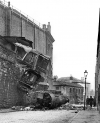Greg Wetzel
Member
Are there any accidents involving tender engines crashing through the back wall of the engine shed? If so, what was the cause of the accident?

A major accident occurred on 10 November 1964 when 43072, an Ivatt 4F, was working a train of twenty-one empty wagons from Ardsley. The driver lost control at Laisterdyke and ran into Adolphus St. goods yard at an estimated speed of 50 mph. Before demolishing the buffers the crew jumped clear and the train crashed through a wall to fall 30ft into Dryden Street below. The 14 year old locomotive was considered beyond economic repair was cut up in the road 4 days later by G.W.Butler of Laisterdyke.
